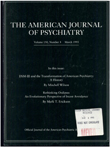Review of bulimia nervosa in males
Abstract
OBJECTIVE: The authors describe the distribution of bulimia nervosa among males and identify characteristics that distinguish male bulimics from their female counterparts. METHOD: Potential references were identified through an English-language literature search using MEDLINE (1966 to April 1990) and through extensive manual searching of textbooks and reviews. All published works with original data or hypotheses concerning bulimia in males were included. RESULTS: Bulimia affects approximately 0.2% of adolescent boys and young adult men, and males account for 10%-15% of all bulimic subjects identified in community-based studies. Compared to their female counterparts, male bulimics appear to have a later age of onset; higher prevalences of premorbid obesity, homosexuality, and asexuality; and less concern with strict weight control. These findings are discussed from biological, psychological, and cultural perspectives to develop a fuller understanding of the pathogenesis of bulimia in males. CONCLUSIONS: Bulimia in males has received relatively little attention in the literature. Future research should focus on more rigorous analytic studies that include matched comparison groups of female bulimic and male nonbulimic subjects. Such studies would not only benefit male bulimics but might provide insight into the nature of bulimia in both sexes.
Access content
To read the fulltext, please use one of the options below to sign in or purchase access.- Personal login
- Institutional Login
- Sign in via OpenAthens
- Register for access
-
Please login/register if you wish to pair your device and check access availability.
Not a subscriber?
PsychiatryOnline subscription options offer access to the DSM-5 library, books, journals, CME, and patient resources. This all-in-one virtual library provides psychiatrists and mental health professionals with key resources for diagnosis, treatment, research, and professional development.
Need more help? PsychiatryOnline Customer Service may be reached by emailing [email protected] or by calling 800-368-5777 (in the U.S.) or 703-907-7322 (outside the U.S.).



